I grew up in a midcentury modern house that boasted a very large pot of mother-in-law’s tongue, and it took me years to actually appreciate the plant and own one myself. Today, I have a nostalgic affection for mother-in-law's tongue
(Sansevieria), but I also see how this wonderfully striking plant works with many design styles, and how easy it is to care for. I’d recommend it to anyone, even those who prefer a houseplant with a softer look.
It truly can take some serious abuse. I'm talking falling-over-and-detaching-from-its-roots neglect, which happened not only on our walk home from the nursery, but at least five times more until I repotted it in deeper soil. Every time one of the larger spikes fell out of the pot and detached from its base, we just stuffed it back in as though nothing had happened.
It’s still alive and well. You really can't beat a houseplant whose leaves form roots when you shove them back into soil. Take a look at what a great addition this independent plant can make to your home:
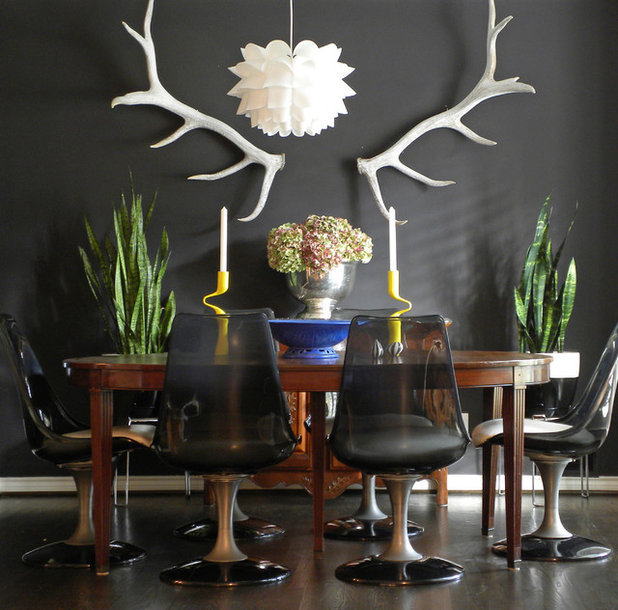
Sarah Greenman
Talk about versatility. What other plant would fare so well in a dramatic, modern, gothic-like setting like this? Mother-in-law's tongue looks great in pairs and is a perfect alternative to the expected sideboard floral arrangement or topiary.
Obviously, mother-in-law's tongue can look a little fierce, which is why it works well in this edgy and mysterious Dallas interior.

Island Architects
The repetition of
Sansevieria-filled pots placed between arches in this Mediterranean-style corridor in Rancho Santa Fe, California, anchor the space and accompany you on the visual journey to the end of the hall.
The plants also help balance the juxtaposition of the larger arched windows with the smaller arched doorways.
And the height of the
Sansevieria allows them to make a statement without stealing the show from the wrought iron details. One wouldn't be surprised to see a coat of arms or even a suit of armor in this setting, so the sword-shaped leaves are a perfect fit.
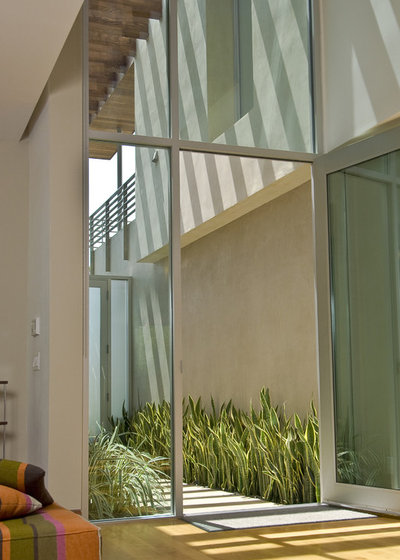
Michael Lee Architects
The sea of mother-in-law's tongue in this Santa Monica, California, home creates a stunning sense of arrival in a partially covered entrance courtyard. The leaves appear to be waving in the wind like a field of wheat while blending in with the rectilinear architectural forms. The fascinating yet subtle play between texture and volume makes this example a true winner.
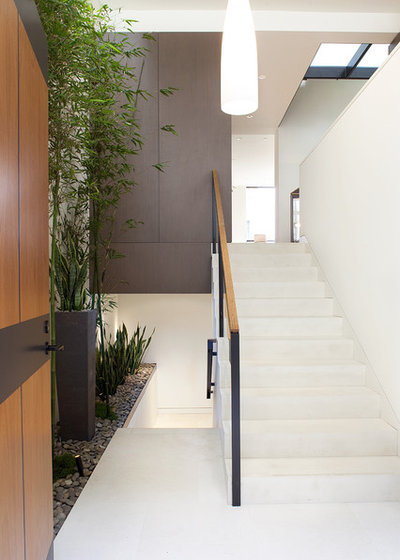
John Maniscalco Architecture
The sleek style of this new San Francisco home demands something clean and sophisticated at the entrance, and mother-in-law's tongue steps up to the plate. Its transitional two-story entry hall with a slice of indoor garden is the perfect place for
Sansevieria. With its questionable light, it needs a plant that is good looking and low maintenance. (I can't say the same about the bamboo, however!)

Swaback Partners, pllc
This Phoenix home's large urn could certainly hold a tree, though I like the modest choice of mother-in-law's tongue. It delineates the indoor space without detracting from the seamless transition of indoor to outdoor. With these massive proportions, the large urn is a necessity because a small pot would look downright silly.

Jordan Parnass Digital Architecture
The plant is right at home in this well-designed and compact studio apartment. Its selection says that this houseplant is low maintenance, doesn't make a mess and has proportions that work in a small space, where visual flow is important.
Seeing this plant here also reminds me of its stature as a houseplant icon in midcentury modern design, so do consider placing one beside your Eames chair.
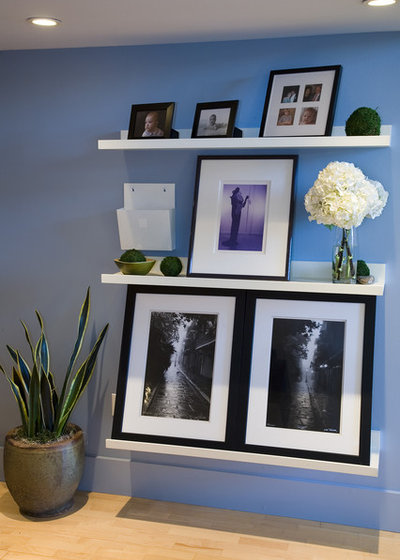
Kimball Starr Interior Design
The entrance hallway in this San Francisco loft is probably dark, so mother-in-law's tongue adds a welcoming touch that won't die from lack of light.
This bit of greenery also offsets the cold (though lovely) tone of the blue walls, serving as a midpoint between the wall color and the black and white artwork. The result is harmonious and pleasant, a nice feeling to come home to.
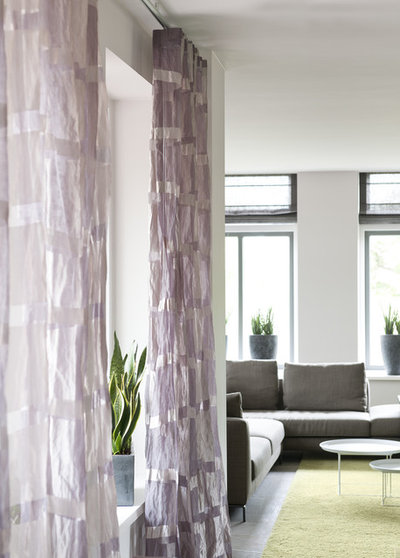
HUISSTYLING
Small pots give a glimpse of green to just about any location. The minimal decor in this Netherlands apartment comes to life with the simple addition of these small pots on every window sill.
And for the Dutch, who live in a climate that is often wet and cloudy, window sills, especially those that face the street, become an opportunity for joyful flower and plant displays. Regardless of where you live, this is a great lesson.
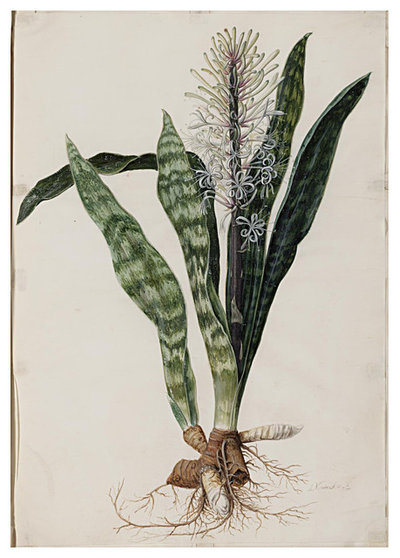
Not convinced yet? I recently discovered that
Sansevieria is a flowering plant. Most of us aren't able to give it the conditions it loves in order to flower, but if you put your plant outside in the summer heat, you may have some success.
Additionally, take a look at the root system, which is similar to ginger. To divide plants and make new ones, one simply cuts the root, called a rhizome, and replants the pieces, with their corresponding leaves, in a new pot. So, if your thumb is just slightly green, within a few years, you could have enough pots of
Sansevieria to start giving to friends.
Plant care tips:- Light requirements: Thrives in bright light but can also tolerate total shade and even partial darkness.
- Temperature: Loves heat but is an adaptable houseplant. Try to place in areas above 50 F.
- Water: Do not overwater, ever. Water roughly once a month in the winter and every two weeks at most in the summer. This plant will not tolerate overly wet soil and easily develops root rot, so only add water to soil that is completely dry.
- Soil: Use cactus mix, basic well-draining potting soil that contains no fertilizer, or combine basic potting soil with pumice.
- Feeding: Not necessary. If desired, Sansevieria should be fertilized with nitrogen-free fertilizer only, and during summer months.
- General care: Dust leaves regularly to keep them looking attractive and to allow the plant to absorb maximum light.
- Air purification: Sansevieria species are believed to act as good air purifiers by removing toxins from the air. Additionally, the plant absorbs carbon dioxide by day and releases oxygen by night, which makes them suitable bedroom plants, though not usually recommended for children's bedrooms (see below).
- Poison index: Sansevieria leaves are potentially poisonous if ingested and should be kept out of small children's reach.
- Natural habitat: Sansevieria trifasciata grows naturally in tropical West Africa.
More: 8 Houseplants You Can't Kill





